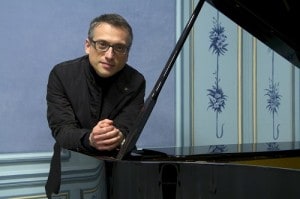Many dancers don’t realize how fortunate they are to have live piano music during their ballet classes. Now that I’m writing about dance, I’ve decided to search around the world for some of these pianists who make their living playing for ballet.
I was astounded when I first heard Massimiliano’s music for ballet class. His music is not only played with the technical expertise of a concert pianist, it is soulful, unique, soaring. And now I have the great honor of introducing my readers to Massimiliano Greco, composer and pianist. He works for Les Ballets de Monte Carlo and is currently the Main Pianist and Music Director for the Académie de Danse Princesse Grace. Here is some of his music for adagio at the barre.
“What most impressed me, and I have to say, even surprised about Massimiliano Greco is his total adjustement, because of being an exquisite pianist and musician, not only to the demands of the dance, of which he is humble and devoted accompanist, but the sensible and intelligent introspection in the ballet world. He follows, underscores the rhythms, the cadences and the fascination of dance, so with him, masterfully, you can listen to dance and see the music.” –Alberto Testa, Dance Journalist, writer of dance books

Inside Ballet: At what age did you begin your piano training?
Massimiliano Greco: I started to study piano at seven years old and it was very casual. I remember I was with my parents at a friend’s house and there was a piano. My mother asked me to try to play it. It took not so much time to understand how it worked and I began to improvise with one finger. Since then I can say that I have always played piano.
Inside Ballet: How did you come to begin accompanying ballet classes?
Massimiliano Greco: When I was younger, I never thought of playing for the ballet. I was trained to become a concert pianist. In fact, towards 1992 I had already done a lot of concerts.
Then unfortunately I had a car accident that stopped me for one month. In that period of sadness I tried other jobs as a pianist. There was a small dance school near my home and someone told me that I could play the piano for ballet classes. I asked the school and they let me try it. And even if I was a little “shocked” from the different working situation, it went really well!
Inside Ballet: What is it that you enjoy most about playing for ballet; what is it that makes you want to continue doing it?
Massimiliano Greco: At the beginning I was interested as a composer. I liked the possibilities of creating a communication between the phrases that drew the dancers in with their arms and legs and phrases of musical melodies. Still now, each time I find dancers capable of connecting their movements with the phrasing of my music something special happens in the air…that’s Art! In that moment I think miracles are possible. In my life I’ve met many passionate dancers and I’m sure I’ll meet many others with whom I’ll create an artistic atmosphere, an artistic communication. Music and dance together can change the world and make it better.
Many dancers and ballet masters asked me to record CDs for their classes, so I made a collection of 12 CDs for ballet classes and choreography. Now I can say that my music is known in many parts of the world.
Inside Ballet: How does someone learn to play for ballet classes? Are there piano books for ballet accompanists, or do you have to find music and put the musical selections together yourself?
Massimiliano Greco: When I started I didn’t know anything about playing for ballet…for me it was very far from my knowledge as a musician. My luck was in starting with RAD syllabus. They have fixed music scores and so I immediately started to understand what kind of music is good for pliés or for a frappe etc. In any case there’s not much, talking about books, about playing for ballet. And about the scores there’s more, but the pianist has to do personal research creating his own repertoire for the exercises in the class.
Usually pianists get their experience playing day by day but many of them give up because at the beginning the work can be very hard and difficult to understand from the normal training of a pianist.
That’s why I decided to teach other pianists to play for ballet. In my academy I’m responsible for a complete “Ballet Pianist Course” to train pianists for this job.
Inside Ballet: Do dance accompanists connect to discuss new ideas with each other (online or otherwise)?
Massimiliano Greco: At the moment there’s not a special connection between ballet pianists. Personally, I know some colleagues all around the world, but they’re casual contacts created from specific occasions. In fact, I want to create an official database of all the ballet pianists in the world—pianists who work in ballet companies, professional academies and freelance ballet pianists—a sort of official professional ballet pianists’ register. Then my idea is to organize an international meeting in which we can meet each other and we can play for classes with the support of ballet masters and dancers. I hope to start the organization of this project in the next season.
Musical Selections and Contact Information
To listen to more of Massimiliano Greco’s music for ballet class or for choreography check out his website Musicaedanze – Music for Ballet Class. He also has a blog at massimilianogreco.blogspot.it.
For more information on ballet class CDs, you may email him at lamusicadimax@gmail.com.
Greco accomplished his musical studies and graduated with the highest marks at the Conservatory of Music “N.Piccinni” of Bari, studying with Maestro Hector Pell. He also studied musical composition with Maestro Ottavio De Lillo, in Bari, and won 1st prize in several piano competitions.


